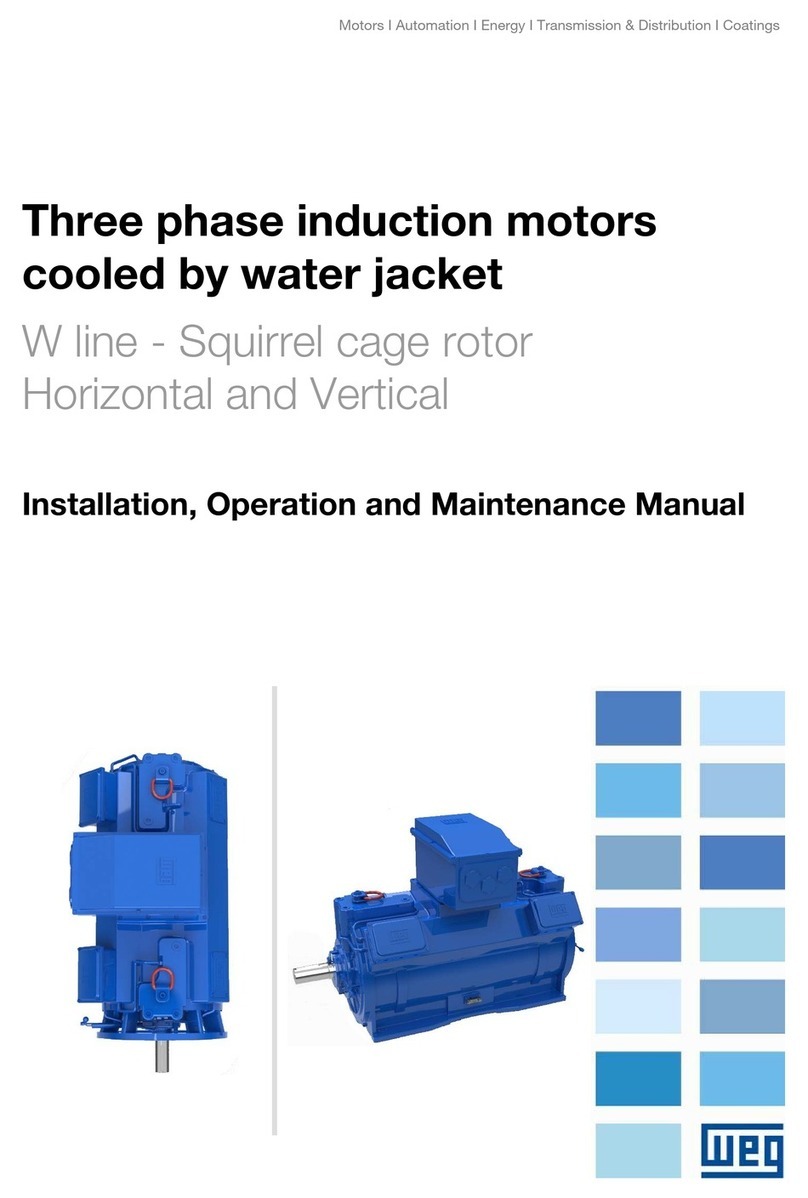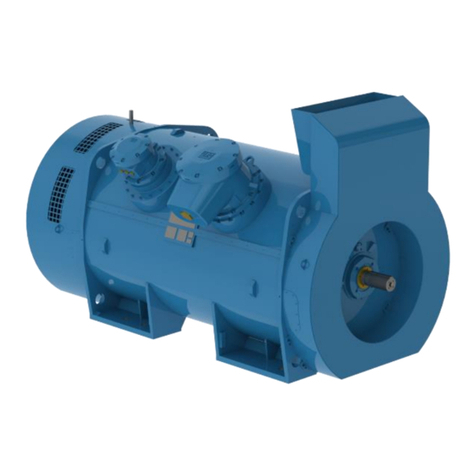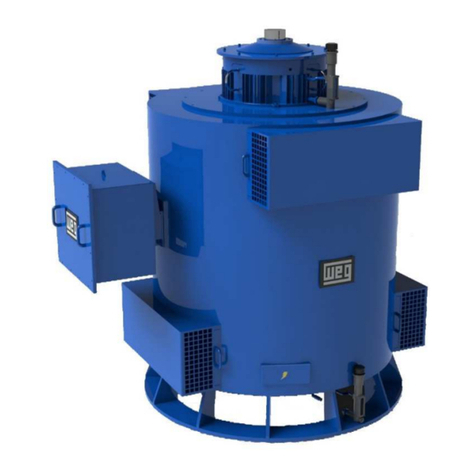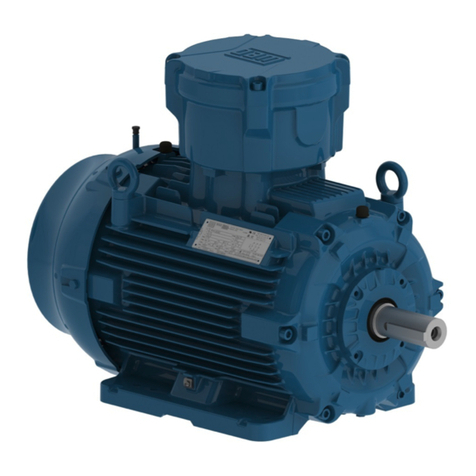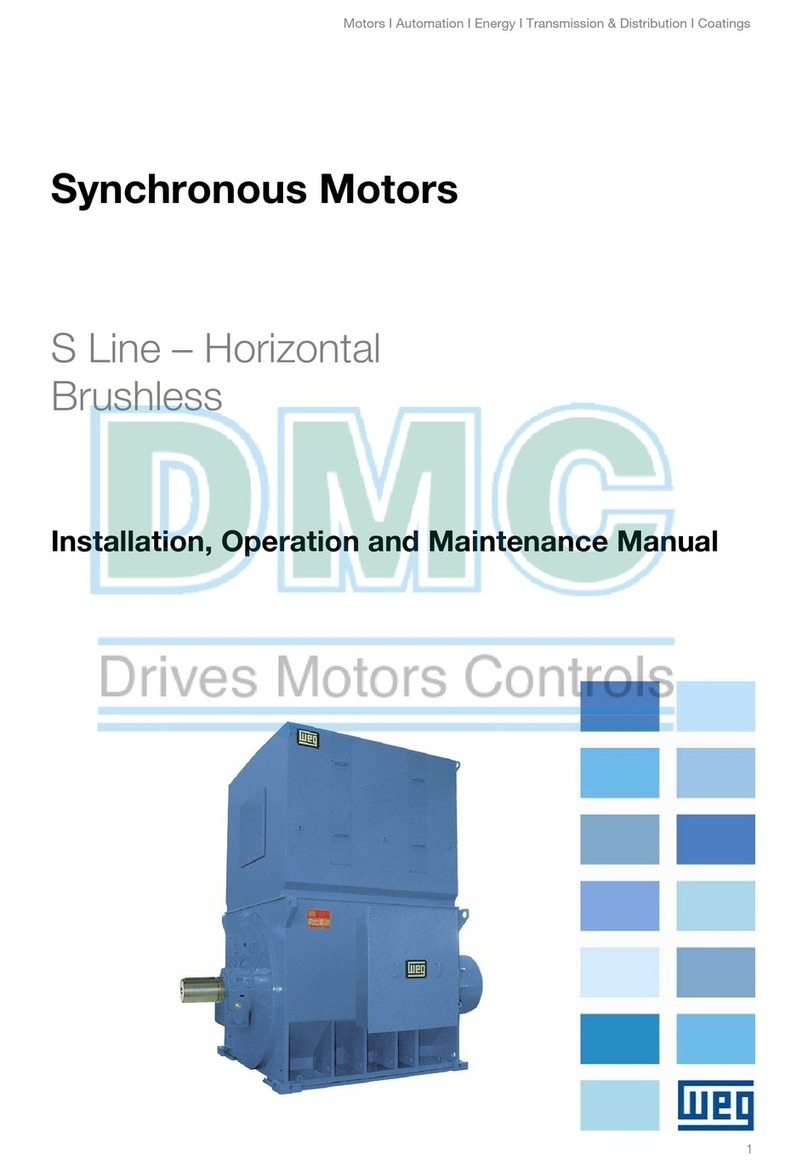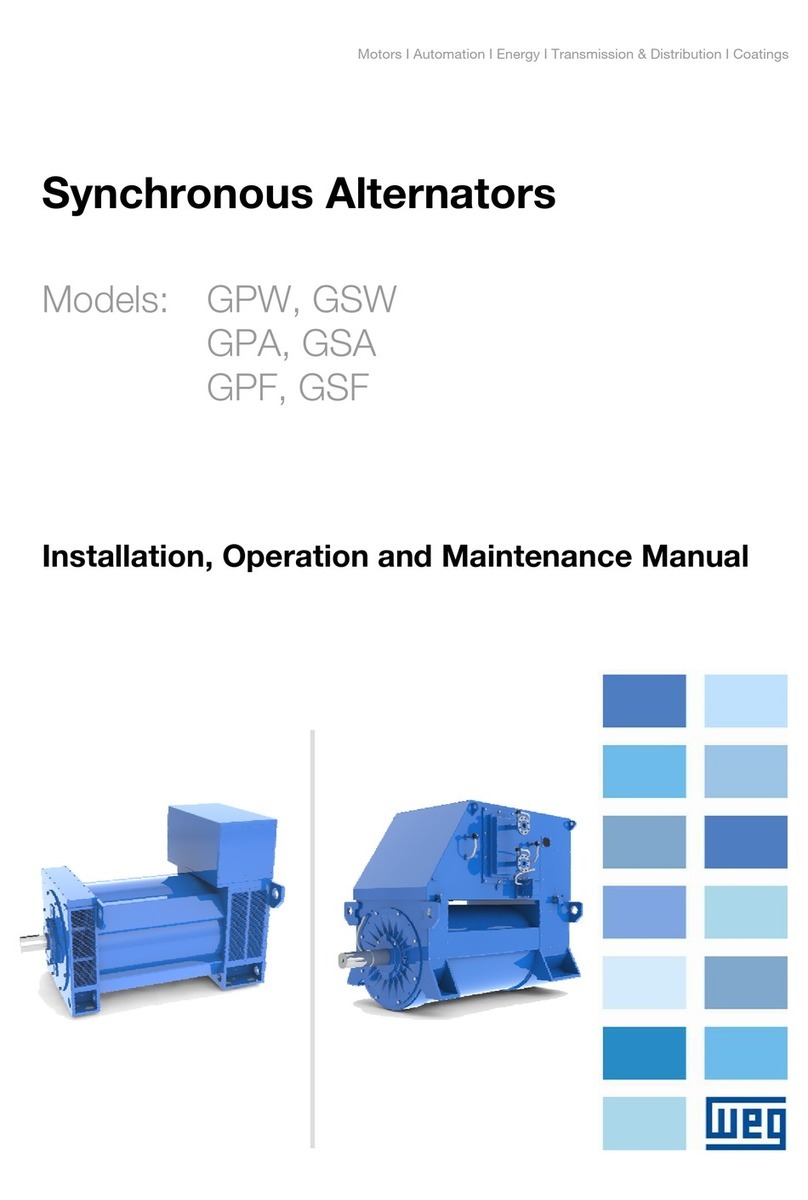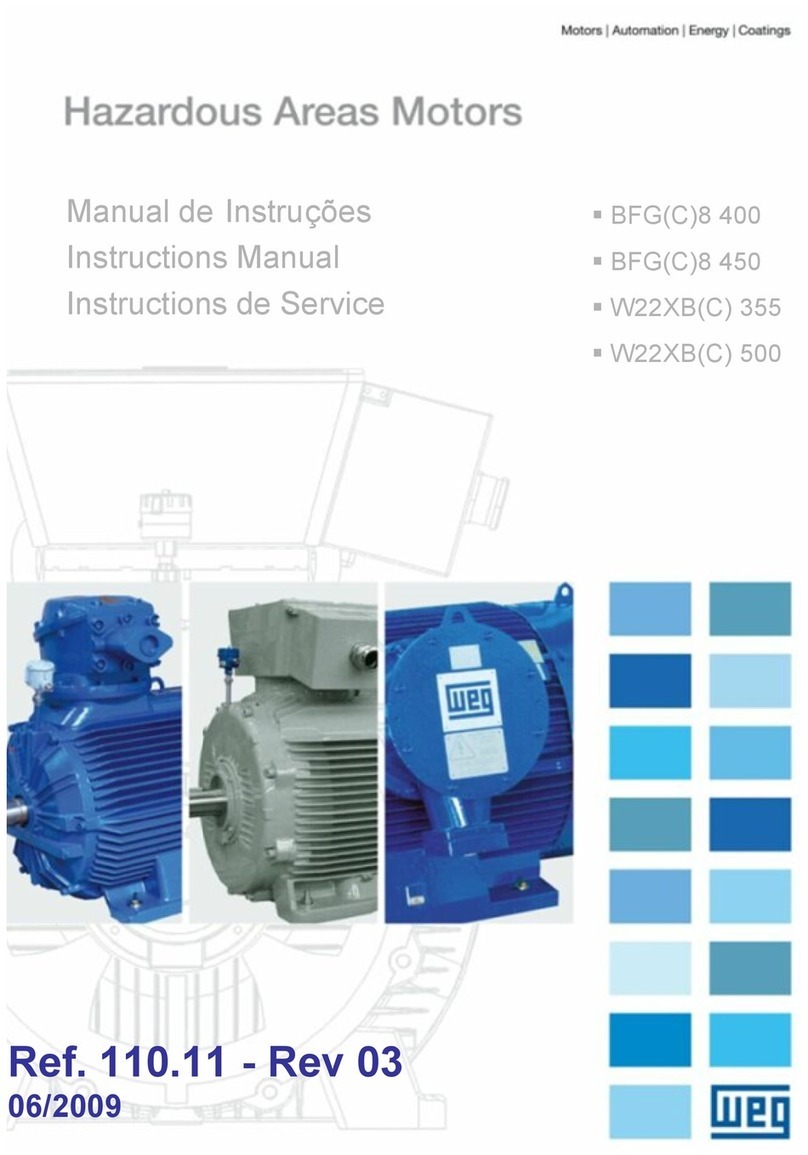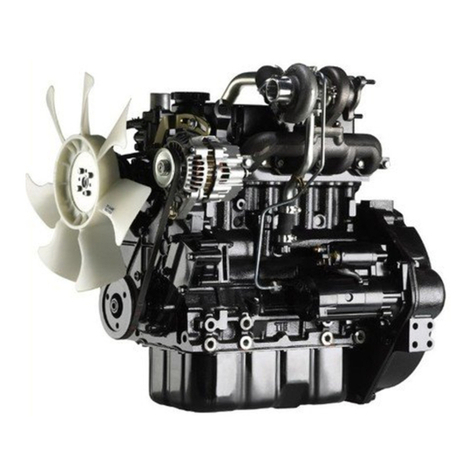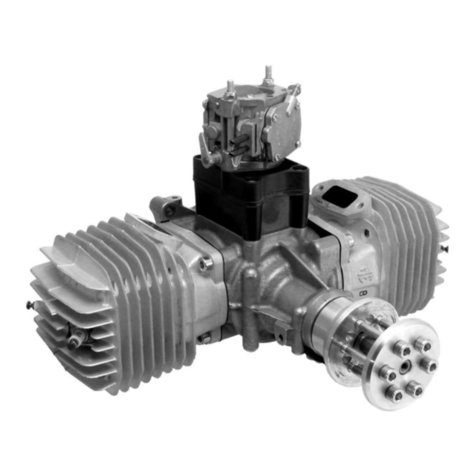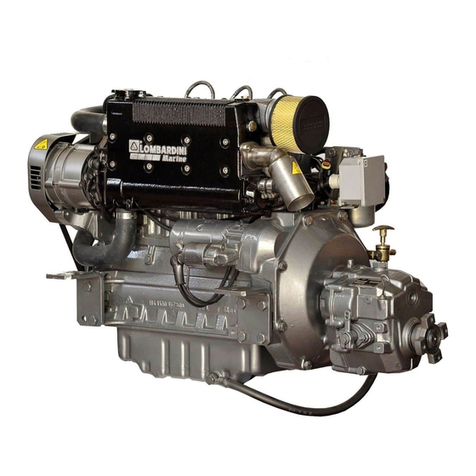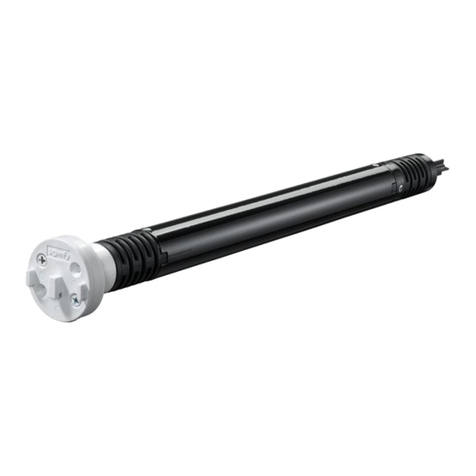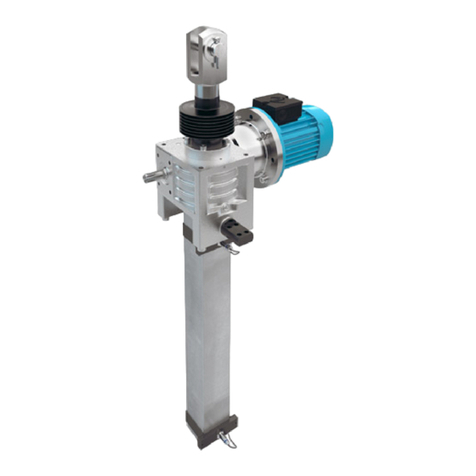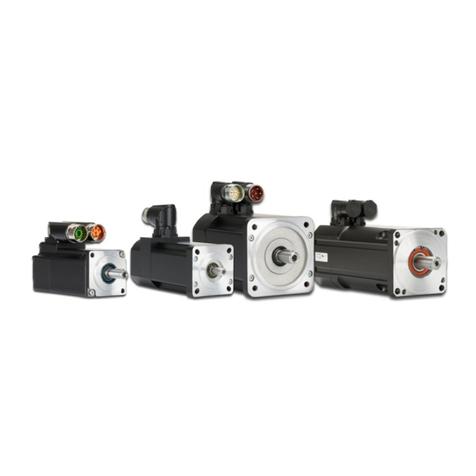WEG W21 Owner's manual

Motores eléctricos para
atmósferas explosivas
Instrucciones de seguridad para instalación,
operación y mantenimiento de motores eléctricos
Motors | Au tomation | En ergy | Transmission & D istribution | Coa tings
Electric motors for
explosive atmospheres
Instructions manual for installation,
operation and maintenance of electric motors
Cod: 5003 4031 | Rev: 11 | Date (m/y): 02/ 2018
The value s shown are subjec t to change without p rior notice.
1 2 3 4
8 9 10 11 12 13 14
5 76
BRAZIL
WEG EQUIPAME NTOS ELÉTRICOS S.A .
Av. Prefeito Walde mar Grubba, 3000
89256-90 0 - Jaraguá do Sul - SC
Phone: 55 (47) 3276-40 00
www.weg.net/br
CHINA
WEG (NANTO NG) ELECTRIC MOTOR MANUFACTURING CO., LTD.
No. 128# - Xinkai South Road,
Nantong Ec onomic &
Technical Development Zone,Nantong, Jiangsu Province.
Phone: (86) 0513-85989333
WEG (Jiangsu) Electric Equipment CO., LTD.
No. 15 Group, North City Street, Dengyuan Community
Rugao City, Jiangsu Province – China
www.weg.net/cn
MEXICO
WEG MEXI CO, S.A. DE C.V.
Carreter a Jorobas-Tula Km. 3.5, Manzan a 5, Lote 1
Fraccionamiento Parque
Industrial - Huehuetoca,
Estado de M éxico - C.P. 54680
Phone: + 52 (55) 5321 4275
www.weg.net/mx
PORTUGAL
WEG EURO - IND ÚSTRIA ELÉCTRICA, S. A.
Rua Eng. Frederico Ulrich
Apart ado 6074
4476-908 - Mai a
Phone(s): +351 229 477 705
www.weg.net/pt
More languages see website www.weg.net
1. INTRODUCCIÓN
La instalación, operación y mantenimiento del motor debe
llevar se siempre a cabo por personal cualificado y autorizado,
utilizando herramientas y métodos adecuados, y siguiendo los
procedimientos indicados en los documentos suministrados
con el motor.
Las instrucciones presentadas en este documento son válidas para
motores WEG con las siguientes características:
gMotores de inducción trifásicos y monofásicos (con rotor de jaula);
gMotores trifásicos de imanes permanentes;
gMotores trifásicos híbridos (con rotor de jaula + imanes
permanentes);
Estos motores pueden ser utilizados en áreas clasificadas con los
siguientes tipos de protección:
gSeguridad Aumentada – “Ex e”;
gTipo de protección “n” – “E x n”;
gA Prueba de Explosión – “Ex d” o “Ex de”;
gProtección por carcasa (polvo conductivo) – “Ex t”;
gClase I División 1;
gClase I División 2;
gClase II División 1;
gClase II División 2.
Los detalles de la marcación pueden ser encontrados en la placa de
características y en el cer tificado del producto, que forma parte de la
documentación del motor. Como referencia, este manual presenta la
lista de certificados para cada tipo de protección y su marcación.
Además de eso, las normas aplicables pueden ser encontradas en
los cer tificados del producto y en el “Manual Gene ral de Instalación,
Operación y Mantenimiento de Motores Eléctricos para Atmósferas
Explosivas” – código 50034162. El manual está disponible en el sitio
web:
www.weg.net.
El objetivo de este manual es aportar informaciones importantes que
deben ser seguidas durante el transporte, almacenamiento,
instalación, funcionamiento y mantenimiento de los motores WEG.
Por ese motivo, recomendamos leer atentamente las instrucciones
antes de hacer cualquier intervención en el motor. El incumplimiento
de las instrucciones reflejadas en este manual, y demás instrucciones
a las que s e hace referencia en el sitio w ww.weg.net, ocasionará la
anulación de la garantía del producto, y puede comprometer e l tipo de
protección del motor y ocasionar serios daños personales y materiales.
Cualquier componente añadido al motor por el usuario,
como por ejemplo, prensa, tapón, encoder, etc., debe
corresponder al tipo de protección de la carcasa , el
“nivel de protección de equipamiento” (EPL) y el grado de
protección del motor, de acuerdo con las nor mas indicadas en
el certificado del producto.
Condiciones especiales de utilización
El símbolo “X” junto al número de certificado, reflejado
en la placa de características del motor, indica que el
mismo requiere condiciones especiales de instalación,
utilización y/o mantenimiento del equipo, siendo éstas
descritas en el certificado y suministradas en la documentación
del motor. Como referencia, el capítulo 8 presenta la lista de
certificados para cada tipo de protección y su marcación en
placa. El incumplimiento de estos requisitos compromete la
seguridad del producto y de su instalación.
La correcta clasificación del área de instalación y de las
características del ambiente es de responsabilidad del usuario.
Los motores eléctricos tienen circuitos bajo tensión, y
componentes giratorios que pueden causar daños a las per sonas.
2. Transporte, almacenamiento y manipulación
Verifique la situación del motor al recibirlo. De encontrarse daños,
estos deben ser informados por escrito a la agencia de transporte, y
comunicarlos inmediatamente tanto a la empresa aseguradora como a
WEG. En es e caso, no se debe inici ar ningún trabajo de instalación h asta
que se haya solucionado el problema encontrado.
Los datos q ue aparecen en la pla ca de caracte rísticas, de ben
corresponder con los del pedido del producto y las condiciones
ambientales de trabajo en el lugar donde el motor será instalado,con el
tipo de protecci ón y nivel de prote cción de equ ipamiento (EPL ). En caso
de que el motor no fu era instala do inmediatamente, s e recomienda
almac enarlo en lu gar limpio y se co, libre de polvo, vibra ciones, gases y
agente s corrosivos, y con una humed ad relativa de l aire no super ior al
60%. Para e vitar la cond ensación de agua en e l interior del motor dur ante
el período de almacenamiento, se recomienda mantener la resistencia de
ESPAÑOL c aldeo ence ndida (de esta r incluida). Par a evitar la oxid ación de los
rodamientos y asegurar una distribución uniforme del lubricante, gire el
eje del motor por l o menos una vez por mes (da ndo, como míni mo, 5
vueltas) y dejándolo siempre en una posición diferente.Para rodamientos
con sis tema de lubricació n tipo “oil mist”, el motor debe e star ubicad o en
posición horizontal, independientementede su forma constructiva, con
aceite I SO VG 68 en el rodam iento, con la can tidad indicada en el m anual
dispo nible en la pág ina web, y el eje de be girarse se manalmente. En caso
de que lo s motores qued en almacena dos por un periodo su perior a 2
años, se recomienda cambiar los rodamientos, o como alternativa,
desmontarlos, lava rlos, revisarlos y l ubricarlos nueva mente antes de
hacer t rabajar el motor. Tras este perío do de almacenamie nto también se
recom ienda que los c ondensadores de a rranque de motores
monofásicos sean cambiados debido a posibles pérdidas de sus
características de trabajo.
Toda manipulación del motor debe ser realizada con
cuidado para evitar impactos y da ños a los cojinetes, y
con el dispositivo de transpor te/bloqueo del eje (de ser
suministrado) siempre instalado. Levante el motor
siempre por los elementos de elevación, los cuales han sido
diseñados para el peso del motor, y nunca deben utilizar se para
levantar cargas adicionales acopladas. Los elementos de
elevación de los componentes, como la caja de bor nes, la tapa
deflectora , etc., deben utilizarse solo para manipula r estas
pieza s cuando estén desmontadas. En el manual general
disponible en la página web, se podrá encontrar información
adicional sobre los ángulos máximos de elevación.
Mida periódicamente la resistencia de aislamiento del motor y sobre
todo, antes de la primera puesta en marcha. Verifique los valores
recomendados y los procedimientos de medición en la página web.
3. Instalación
Durante la instalación, los motores deben estar
protegidos contra puestas en marcha accidentales.
Verifique el sentido de rotación del motor, haciéndolo
funcionar en vacío antes de acoplarlo a la carga.
Elimine los dispositivos de transp orte y de bloqu eo del eje (en caso que
exista n) antes de inici ar la instalación del motor.
Los motores solo deben estar instalados en lugares compatibles con
sus características constructivas y en las aplicaciones y ambientes
reflejados en la documentación del producto.De be ser respetado el tipo
de protec ción y el EPL indicados e n la placa de características del motor,
de acuerdo con la clasificación del área donde el motor será instalado.
Los motores con patas deb en estar ubicados sobre bases
debidamente proyectadas para evitar vibraciones y asegurar un perfecto
aline amiento. El eje del motor debe est ar adecuadamente alineado con
el eje de la máquina accionada.
Un alineamiento incorrecto, así como una tensión inadecuada de las
correas de accionamiento, seguramente dañarán los rodamientos,
resultando en excesivas vibraciones e incluso causar la ruptura del eje.
Se deben respetar las cargas radia les y axiales admi sibles en el eje, las
cuale s se indican en el manual general di sponible en la página web. Se
recomienda el uso de acoplamientos flexibles.
En los motores con rodamientos cuya lubricación sea a base de aceite o
un sistema de lubricación tipo “oil mist”, conecte los tubos de
refrigeración y lubricación (caso de estar disponibles).
Para coj inetes con lubricación a aceite, el nivel de aceite de be
permanecer en la mi tad del visor de nivel.
Elimine la grasa de prote cción contra corrosión de la punta del eje y de la
brida únicamente justo antes de la instalación del motor.
A no ser qu e se especifique lo contrario en el pedido de compra, los
motores WEG se equilibran dinámicamente con “media chaveta” y en
vacío (desacoplados). Los elementos de transmisión, como poleas,
acoplamientos, etc., deb en equilibrarse antes de ser instalados e n el eje
de l motor.
Los motores siempre deben estar posicionados de
forma que el dr enaje sea facilitado (en el punto mas bajo
del motor). Motores con drenaje de g oma salen de la
fabrica en la posicion cerrado y deben ser abi ertos
periodica mente para permitir la sa lida del agua conde nsado. Para
ambientes con elevada condensacion del agua y motores con
grado de proteccion IP55, los dre najes pueden ser armados en la
posic ion abierto. Para motores con gr ado de proteccion IP56,
IP65 o IP 66, los drenajes deben pe rmanecer en la pos icion
cerrado, siendo abiertos solamente durante el mantenimiento del
motor.
Los motores co n lubricacion de tipo Oil Mist deb en tener sus
drenajes conectados a un sistema de recoleccion especifico.
Los dre najes de motores a pr ueba de explosión no se pueden
quitar durante los procedimientos de instalación y mantenimiento.
Para el dimensionamiento de los cables de alimentación y de
los dispositivos de maniobra y protección se debe considerar
la corriente nominal del motor, el factor de servicio, la longitud
de los cables, entre otros.
Para motores sin placa de bornes, aísle los terminales del
motor, utilizando materiales aislantes compatibles con la clase
de aislamiento informada en la placa de características.
La distancia mínima de aislamiento entre partes vivas no
aisladas entre sí y entre partes vivas y la tierra debe respetar
las normas y reglamentaciones vigentes en cada país.
Tabla 3 - Temperatura máxima de actuación de las protecciones térmicas
No cubr a u obstruya la ventilación del motor. Mante nga
una dis tancia libre mínimo de ¼ (25%) del d iámetro de
la entrada de aire de la deflectora en relación a la
distancia d e las parede s. El aire utilizado para l a refriger ación del
motor debe estar a temperatura ambiente, limitada a la
temperatura indicada en la placa de características del motor
(caso de no estar indi cado, considerar de -20 °C a +40 °C).
Para motores instalados a la intemperie o montados en la
posición vertical, se necesitará utilizar una protección adicional
contra la entrada de líquidos y/o partículas sólidas, por ejemplo,
el uso de un sombrerete.
Para evitar accidentes, con anterioridad al arr anque del motor,
se ha de asegurar que la puesta a tierra fue realizada conforme a
las normas vigentes y que la conexión esté bien apretada.
Conecte el motor correct amente a la red eléctrica a través de
contactos seguros y permanentes, siguiendo siempre los datos
mostrados en la placa de características, como la tensión
nominal, el esquema de conexionado, etc.
Cuando se utilicen terminales, todos los conductores que forman
el cable tren zado deben estar fi jados dentr o de la camisa . El
aislamiento de los cables de los accesorios debe ser mantenido
hasta 1 mm desde el pun to de conexión del conector.
Para la conexión del cable de alimentación, sistema de puesta a tierra
y montaje de la tapa de la caja de bornes, deben ser respetados los
pares de apriete indicados en las Tablas 1 y 2.
Tabla 1 - Pares de apriete para elementos de fijación [Nm]
Notas:
1) La cantidad y e l tipo de p rotecci ón térmi ca insta lada en e l motor está n
inform ados en la s placas a dicion ales de l mismo.
2) En el caso d e protecc ión térm ica con re sisten cia cali brada ( por eje mplo,
Pt-100), el sistema de mo nitore o debe se r ajustad o a la tempe ratura de
operac ión ind icada e n la Tabla 3.
Tomar las medidas necesarias para asegurar el tipo
de protección, el EPL y el grado de protección
indicado en la placa de identificación del motor:
- En las entradas de cables no utilizadas de la caja de
conexiones, las cuales deben ser debidamente cerradas con
tapones certificados;
- En componentes suministrados de forma independiente
(por ejemplo cajas de conexiones montadas por separado).
Las entradas de cables utilizadas para alimentación y control
deben emplear componentes (como, por ejemplo, prensas y
pasacables) que respeten las normas y reglamentaciones
vigentes en cada país. Para motores “Ex d”, los pasacables
están permitidos solamente para equipamientos eléctricos
del grupo II.
Los elementos de fijación montados en agujeros roscados
pasantes del involucro del motor (por ejemplo, en la brida)
deben ser sellados, con los productos enumerados en el
punto 5, para asegurar el grado de protección indicado en la
placa de identificación del motor.
El motor debe ser protegido con dispositivos de protección contra
sobrecarga. Estos dispositivos de protección pueden ser integrados
en el motor (tales como termistores en los devanados) o dispositivos
de protección externos, donde la carga del motor se controla por la
corriente nominal. Para motores trifásicos se recomienda también la
instalación de sistemas de protección contra fallo de fase.
Componente
Marcación del
área clasificada
en la placa de
identificación
Área clasificada
donde el
producto será
instalado
Temperatura máxima de
operación (°C)
Alarma Apagado
Bobinado
Ex d Ex d 130 150
Ex n Ex n 130 155
Ex t Ex t 120 140
Ex e Ex e - 110
Ex n + Ex t Ex n 140 155
Ex t - 140
Ex d + Ex t Ex d 140 150
Ex t - 140
Class I Div. 1 Class I Div. 1 130 150
Class I Div. 2 Class I Div. 2 130 155
Class II Div. 1 Class II Div. 1 120 140
Cojinete Todas Todas 110 120
Tipo de
protección Componente M4 M5 M6 M8 M10 M12 M14 M16 M20
Clase I
División 1
Clase II
División 1
Clase I
Zona 1
Tapa d e
la caja de
conexión
Clase
8.8 /12.9-3,5 a 5 6 a 12 14a 3 0 28 a 6 0 45a 105 75 a 110 115 a
170
230 a
330
Clase
A2-70 /
A4-70
-3,5 a 5 6 a 8,5 14 a 19 28a 4 0 45 a 6 0 75 a 100 115 a
170
225 a
290
Puesta a tierra 1,5 a 3 3 a 5 5 a 10 10 a 18 28a 4 0 45 a 70 -115 a
170 -
Placa de bornes 1 a 1,5 2 a 4 4 a 6,5 6,5 a 9 10 a 18 15,5 a 30 -30 a 50 50 a 75
Clase I
División 2
Clase II
División 2
Clase I
Zona 2
Tapa de la caja de
conexión -3 a 5 4a 8 8 a 15 18a 3 0 25 a 40 30 a 45 35 a 50 -
Puesta a tierra 1,5 a 3 3 a 5 5 a 10 10 a 18 28a 4 0 45 a 70 -115 a
170 -
Pinos de la Pl aca
de bornes 1a 1,5 2 a 4 4 a 6,5 6,5 a 9 10 a 18 15,5a 3 0 -30 a 50 50 a 75
Tornillosde fijación
de la placa d e
bornes -3 a 5 5 a 10 10 a 18 28 a 40 45 a 70 75 a 110 115 a
170 -
Tabla 2 - Pares de apriete para prensa cables y tapón [Nm]
Rosca Material M16 M20 M25 M32 M40 M50 M63 M80
Métrica Plástico 3 a 5 3 a 5 6 a 8 6 a 8 6 a 8 6 a 8 6 a 8 6 a 8
Metálico 40 a 50 40 a 50 55 a 70 65 a 80 8 0 a 100 100 a 120 115a 140 160 a 190
Rosca Material NPT
1/2"
NPT
3/4"
NPT
1"
NPT
1 1/2"
NPT
2"
NPT
2 1/2"
NPT
3"
NPT
4"
NPT Plástico -5 a 6 6 a 8 6 a 8 6 a 8 6 a 8 6 a 8 6 a 8
Metálico 40 a 50 40 a 50 55 a 70 65 a 80 100 a 120 115 a 140 150 a 175 200 a 240
Los motores con conexión triángulo deben ser protegidos contra la
caída de una de las fases. Para eso, se
debe conectar el relé en serie con las fases del devanado y ajustarlo
en 0,58 veces la corriente nominal.
Para motores Clase I y II División 1 y / o motores accionados por
convertidor de frecuencia, es obligatorio el uso de protecciones
térmicas (excepto las clases de temperatura T2B o más).
Para motores División 2 o área segura, el uso de las protecciones
térmicas es opcional.
Para motores sin placa de bornes, no forzar los cables
de alimentación pa ra el interior para evitar contacto
con el rotor.
Verifique el correcto funcionamiento de los accesorios (freno,
encoder, protección térmica, ventilación forzada, etc.) instalados en el
motor ante s del arranque.
Los límites de temperatura de alarma y disparo de las protecciones
térmicas pueden ser definidos de acuerdo a la aplicación, no
obstante, no deben sobrepasar los valores indicados en la Tabla 3.
4. Funcionamiento
Durante el funcionamiento, no toque las zonas
con riesgo de contacto eléctrico, y nunca toque o
permanezca muy cerca de partes giratorias.
Asegúrese de que la resistencia de caldeo esté
desconectada durante el funcionamiento del
motor.
Los valores nominales de trabajo y las condiciones de
funcionamiento están especificados en la placa de características
del motor. Las variaciones de la tensión y la frecuencia de
alimentación nunca deben exceder los límites establecidos en las
normas vigentes. Posibles desvíos en relación al normal
funcionamiento (actuación de las protecciones térmicas, aumento
de los niveles de ruido y vibración, temperatura y corriente) deben
ser evaluados por personal cualificado.
No se recomienda la utilización de rodamiento de cilindros para
acoplamiento directo. Los motores equipados con estos
rodamientos necesitan una carga radial mínima para garantizar su
correcto funcionamiento.
Los sistemas de lubricación de los cojinetes de aceite u “oil mist” y
de refrigeración tienen que permanecer conectados incluso tras el
5. Mantenimiento
Antes de iniciar cualquier tipo de servicio en el
motor, éste debe estar completamente parado,
desconectado de la red de alimentación y
protegido contra una posible reconexión. Aunque
el motor estuviese parado, puede haber tensión en los
terminales de las resistencias de caldeo.
El desmontaje del motor durante el período de garantía
solamente debe ser realizado por un servicio técnico
autorizado WEG para atmósferas explosivas.
En el caso de motores con rotor de imanes permanentes
(lineas W22 Quattro y W22 Magnet), el montaje y desmontaje
del motor requiere de la utilización de dispositivos
adecuados debido a las fuerzas de atracción o de repulsión
entre piezas metálicas. Este servicio solamente debe
llevarse a cabo por un Servicio Técnico Autorizado WEG con
formación específica para dicha operación.
Las personas que utilicen marcapasos no pueden manipular
estos motores. Los imanes permanentes también pueden
causar perturbaciones o daños en otros equipamientos
eléctricos y componentes durante el mantenimiento.
Para motores a prueba de explosión o con protección por
carcasa, abra la caja de conexión y/o desmonte el motor
solamente cuando la temperatura superficial esté a la
temperatura ambiente.
En los motores de las líneas W50 y HGF, suministrados con
ventiladores axiales, el motor y el ventilador axial tienen
indicación de sentido de rotación distintas, para prevenir un
montaje erróneo. El ventilador debe ser montado de tal
forma que la flecha indicativa del sentido de rotación este
siempre visible, cuando observadas desde el lado externo
del motor (en el lado no accionado). La marca indicada en
las aspas del ventilador, CW para sentido de rotación
horario o CCW para sentido de rotación anti-horario, indica
el sentido de rotación del motor.
Para el montaje de las tapas de la caja de conexión, observe los
pares de apriete indicados en la Tabla 1.
En caso de reemplazo de un elemento de fijación, es necesario
que la calidad y las dimensiones del mismo sean respetadas.
Para motores a prueba de explosión, los elementos de fijación
deberán tener una resistencia a tracción igual o superior a clase
12.9, para material de acero carbono y, clase A2-70 o A4-70, en
material de acero inoxidable.
Motores que poseen riesgo potencial de acumulación de carga
electrostática, suministrados debidamente identificados, deben
ser limpiados de manera cuidadosa, como por ejemplo, con
uso de paño húmedo, a fin de evitar la generación de
descargas electrostáticas.
Tabla 4 - Holgura má xima entre tapa y caja de conexión
Para motores con protección por carcasa (del grupo III), se
permite una capa de polvo combustible sobre el envoltorio de
un máximo de cinco milímetros (5 mm).
Inspeccione periódicamente el funcionamiento del
motor según su aplicación, asegurándose de que el
aire fluya libremente. Inspeccione los sellos, los
tornillos de fijación, los cojinetes, los niveles de vibración y
ruido, los drenajes, etc.
El intervalo de lubricación está especificado en la placa de
identificación del motor.
6. Instrucciones adicionales
Para informaciones adicionales sobre transporte, almacenaje,
manipulación, instalación, funcionamiento y mantenimiento de
motores eléctricos, entre en
www.weg.net.
Para aplicaciones y condiciones especiales de trabajo (ejemplo:
motores de extracción de humos, totally enclosed air over (TEAO),
motores para altas cargas radiales y axiales, motores con freno,
motores con encoder) se debe consultar el manual específico
suministrado con el equipamiento, o el manual en el sitio o entrar
en contacto con WEG.
Al entrar en contacto con WEG, tenga a mano la denominación
completa del motor, así como también su número de serie y fecha
de fabricación indicados en la placa de características del mismo.
7. Términos de garantía
WEG Equipamentos Elétricos S/A, Unidad Motores (“WEG”),
ofrece garantía contra defectos de fabricación o de materiales para
sus productos por un período de 18 meses, contados a partir de la
fecha de emisión de la factura de fábrica, o del distribuidor/
revendedor, limitado a 24 meses de la fecha de fabricación.
Para motores de la línea HGF, la garantía ofrecida es de 12 meses,
contados a partir de la fecha de emisión de la factura de fábrica, o
del distribuidor/revendedor, limitado a 18 meses a partir de la fecha
de fabricación.
El párrafo anterior cuenta con los plazos de garantía legal, no
siendo acumulativos entre sí.
En caso de que un plazo de garantía diferenciado esté definido en
la propuesta técnica comercial para un determinado suministro,
éste prevalecerá por sobre los plazos definidos anteriormente.
Los plazos establecidos anteriormente no dependen de la fecha
de instalación del producto ni de su puesta en operación.
8. Certificados
Las siguientes tablas muestran la lista de motores para cada
tipo de protección, sus certificados y su marcación en la placa
de características:
Ante un desvío en relación a la operación normal del producto, el
cliente debe comunicar inmediatamente por escrito a WEG sobre
los defectos ocurridos, y poner a disposición el producto para
WEG o su Asistente Técnico Autorizado por el plazo necesario
para la identificación de la causa del desvío, verificación de la
cobertura de garantía, y para su debida reparación.
Para tener derecho a la garantía, el cliente debe cumplir las
especificaciones de los documentos técnicos de WEG,
especialmente aquellas previstas en el Manual de Instalación,
Operación y Mantenimiento de los productos, y las normas y
regulaciones vigentes en cada país.
No poseen cobertura de garantía los defectos derivados de
utilización, operación y/o instalación inadecuadas o inapropiadas
de los equipos, su falta de mantenimiento preventivo, así como
defectos derivados de factores externos o equipos y
componentes no suministrados por WEG.
La garantía no se aplica si el cliente, por iniciativa propia, efectúa
reparaciones y/o modificaciones en el equipo sin previo
consentimiento por escrito de WEG.
La garantía no cubre equipos, partes y/o componentes, cuya vida
útil sea inferior al período de garantía. No cubre, igualmente,
defectos y/o problemas derivados de fuerza mayor u otras causas
que no puedan ser atribuidas a WEG, como por ejemplo, pero no
limitado a: especificaciones o datos incorrectos o incompletos por
parte del cliente, transporte, almacenado, manipulación,
instalación, operación y mantenimiento en desacuerdo con las
instrucciones suministradas, accidentes, deficiencias de obras
civiles, utilización en aplicaciones y/o ambientes para los cuales el
producto no fue proyectado, equipos y/o componentes no
incluidos en el alcance de suministro de WEG. La garantía no
incluye los servicios de desmantelamiento en las instalaciones del
cliente, los costos de transporte del producto, los costos de
locomoción, hospedaje y alimentación del personal de Asistencia
Técnica, cuando sean solicitados por el cliente.
Los servicios en garantía serán prestados exclusivamente en
talleres de Asistencia Técnica autorizadas por WEG o en su propia
fábrica. Bajo ninguna hipótesis, estos servicios en garantía
prorrogarán los plazos de garantía del equipo.
La responsabilidad civil de WEG está limitada al producto
suministrado, no responsabilizándose por daños indirectos o
emergentes, tales como lucros cesantes, pérdidas de ingresos y
similares que deriven del contrato firmado entre las partes.
Los motores con grado de protección superior a IP55 son
suministrados con elemento sellador en los encajes y tornillos. Antes
de montar los componentes mecanizados (por ejemplo, tapas de la
caja de conexión de motores a prueba de explosión), limpie las
super ficies y aplique una nueva capa de este producto.
Para motores a prueba de explosión, utilice en los encajes solamente
los siguientes productos anticorrosivos: Lumomoly PT/4 (fabricante
Lumobras para rango de temperatura ambiente -20 °C a +80 °C) o
Molykote DC 33 (fabricante Dow Corning para rango de -55 °C a +80
°C). Para los demás tipos de protección, utilice en los encajes el
producto Loctite 5923 (fabricante Henkel).
Para motores a prueba de explosión, debe tenerse un cuidado
adicional con las superficies mecanizadas para paso de de llama, de
manera de no contener rebordes, roturas, etc., que reduzcan su
longitud y/o aumenten la holgura del paso de llama. Para las cajas de
borne s a prueba de llama y sus respectivas tapas, la holgura entre las
mismas no debe exceder los valores indicados en la Tabla 4.
corte de alimentación, y hasta la parada total de la máquina.
En caso de fallas en el sistema de lubricación y/o refrigeración,
desconecte el motor inmediatamente.
Tras la parada del motor, los sistemas de refrigeración y de
lubricación (de existir) deben desconectarse y se deben
conectar las resistencias de caldeo (de existir).
En caso de dudas, desconecte el motor inmediatamente y
contacte al asistente técnico autorizado WEG para atmósferas
explosivas más cercano.
Línea de
producto Carcasa
Junta plana Junta cilíndrica
Holgura
(max)
Largo
(min)
Holgura
(max)
Largo
(min)
W21Xd
IEC 90 hasta 355
NEMA 143
hasta 586/7
0,05 mm Bajo
consulta No disponible
W22Xd
IEC 71 y 80
No disponible 0,15 mm 12,5 mm
IEC 90 hasta 355
NEMA 143
hasta 586/7
0,075 mm 6 mm 0,15 mm 19 mm
Certificados UL:
Modelo Marcaje Nº Certificado
Div 1 - Zona peligrosa
Carcasas 143-326,
trifásico
Class I, Div 1,
Groups C and D, T4 File E87848 - Sec 1
Class II, Div 1,
Groups F and G, T4
Carcasas 364-587,
trifásico
Class I, Div 1,
Groups C and D, T3C File E87848 - Sec 2
Class II, Div 1,
Groups F and G, T3C
Carcasas 56 and 61
trifásico/monofásico
Class I, Div 1,
Group D, T3B File E87848 - Sec 3
Carcasa 61,
trifásico/monofásico
Class I, Div 1,
Group D, T3C File E87848 - Sec 4
Carcasas 254-326
trifásico
Class I, Div 1,
Groups C and D, T4 File E87848 - Sec 5
Class II, Div 1,
Groups F and G, T4
Carcasas 364-587
trifásico
Class I, Div 1,
Groups C and D, T4 File E87848 - Sec 6
Class II, Div 1,
Groups F and G, T4
Certificados CSA:
Modelo Marcaje Nº Certificado
Div 1 - Zona peligrosa
Carcasas 143-587,
trifásico
Class I, Div 1,
Groups C and D, T3C 1629892
Class II, Div 1,
Groups F and G, T3C
Carcasa 56
trifásico/monofásico
Class I, Div 1,
Groups C and D, T3C File LR 50962
Class II, Div 1,
Groups F and G, T3C
Carcasa 61
trifásico/monofásico
Class I, Div 1,
Group D, T3C File LR 50962
Carcasa 56
trifásico/monofásico
Class I, Div 1,
Group D, T3C
Div 2 - Zona peligrosa
Carcasas 56, 143-587,
trifásico (W21)
Class I, Div 2,
Groups A, B, C and D, T4 - T2D 1619832
Class II, Div 2,
Groups F and G, T4 - T2D
Carcasas 143-587,
trifásico (W22)
Class I, Div 2,
Groups A, B, C and D, T5 - T2B 2156668
Class II, Div 2,
Groups F and G, T6 - T3C
Carcasas 5006-9610,
trifásico (HGF)
Class I, Div 2, Groups A, B, C and
D, T3 or T3C
1959652
Class II, Div 2, Groups F and G,
T3 or T3C
Carcasas 5009/10-
7008/09, trifásico (W50)
Class I, Div 2, Groups A, B, C and
D, T3 or T3C
Class II, Div 2, Groups F and G,
T3 or T3C
Carcasas 447/9-588/9,
trifásico (W22 Media
tensión)
Class I, Div 2, Groups A, B, C and
D, T3A, T3B, T2D, T4A or T5
Class II, Div 2, Groups F and G,
T3A, T3B, T2D, T4A or T5
Carcasas 5010, L5010,
L5810 and L6808/09,
trifásico (W40)
Class I, Div 1, C and D, T4
En la aplicaci ón de motores “Ex e”, el dispositivo de protecc ión térmica,
en caso de sobrecarga o de rotor bl oqueado, debe actuar con tie mpo
retardado, en función de la corriente y comprobaciónde los cable s de
alimentación externos. El tiempo “tE” indicado en la p laca del motor no
podrá ser reba sado. Los motores “ Ex e”, someti dos a condiciones de
tiempo de aceleración mayor a 1,7 x tiempo “tE”, deben ser protegidos
con dispositivo de protección contrasobrecorrie nte.
Los motores equipados con protectores térmicos del tipo
Automático se reconectarán automáticamente cuando se
alca nce la temper atura adec uada para el motor.
No utilizar motores con protección tér mica del tipo
automática en aplicaciones en donde el rearranque automático
pueda ser peligroso para personas o par a el equipamiento.
En caso de que se a ctive la protecció n térmica del t ipo
Automático, desco necte el motor de la red eléctrica y verifique la
causa que provocó la actuac ión del protector térmico.
Para más inform ación sobre el uso del inverso r de frecuenc ia es
obligatorio seguir las instrucciones del manual del motor en www.weg.
net y del manual del convertidor de frecue ncia.

19 20 21
22
23 24 25
15 16 17 18
26 27 28
5. Maintenance
Before any service is performed, ensure that motor
is at standstill, disconnected from the power supply
and protected against accidental energization. Even
when the motor is stopped, dangerous voltages may be
present in space heater terminals.
Motor disassemble during the warranty period must be
performed by a WEG authorized service center for Explosive
Atmospheres only.
In “Ex e” motors application, the thermal protection device, in
case of overload or locked rotor, must actuate with time delay
according to the current and track the external power cables.
The “tE” time indicated in the motor nameplate can not be
exceeded. The “Ex e” motors, submitted to acceleration time
conditions greater than 1,7 x “tE” time, must be protected with
protection devices against overcurrent.
Motors fitted with Automatic Thermal Protectors will
reset automatically as soon as the motor cools
down. Thus, do not use motors with Automatic
Thermal Protection in applications where the auto-
reseting of this device may cause injuries to people or
damage to equipment. If the Automatic Thermal Protector
trips, disconnect the motor from the power supply and check
the cause why the thermal protector trips.
For more information about the use of variable frequency drives,
you must follow the instructions in the motor manual in the
website and in the manual of the variable frequency drive.
For terminal box cover mounting, please follow the tightening
torques indicated on Table 1 for fixing bolts.
In case of replacement of a fixing bolt, it is necessar y to keep its
Tab le 4 - Ma ximum clearance between terminal box a nd
terminal box cover for flameproof motors
Notes:
1)The quant ity and t ype of the rmal pr otectio ns instal led in the m otor are
infome d in the add itiona l namepl ates incl uded on i t.
2) In case of ca librate d therm al prote ction (for e xample, P t-100), the
monitor ing syste m must be set at t he oper ation tem peratu re indic ated
on Table 3.
Component
Classified area
marked on
nameplate
Classified area
where product
will be installed
Maximum operating
temperature (°C)
Alarm Tripping
Winding
Ex d Ex d 130 150
Ex n Ex n 130 155
Ex t Ex t 120 140
Ex e Ex e - 110
Ex n + Ex t Ex n 140 155
Ex t - 140
Ex d + Ex t Ex d 140 150
Ex t - 140
Class I Div. 1 Class I Div. 1 130 150
Class I Div. 2 Class I Div. 2 130 155
Class II Div. 1 Class II Div. 1 120 140
Bearings All All 110 120
dimensions and quality of material. For flameproof motors, the
yield stress of the fastener elements of motor and terminal
boxes enclosures must be at least equal to class 12.9 for
carbon steel bolts and class A2-70 or A4-70 for stainless steel
bolts.
Motors which may have a potential risk of electrostatic charge
accumulation, supplied duly identified, must receive proper
cleaning and maintenance interventions, i.e. with the use of a
damp cloth, avoiding electrostatic discharges.
For Protection by Enclosure motors (group III), the maximum
permissible dust layer on the motor enclosure is five millimeters
(5 mm).
Regularly inspect the operation of the motor,
according to its application, and ensure a free air
flow. Inspect the seals, the fastening bolts, the
bearings, the vibration and noise levels, the drain
operation, etc. The lubrication interval is specified on motor the
nameplate.
6. Additional information
8. Certificates
A list of the motors for each Type of Protection, their certificates
and markings is shown below:
Model Marking Certificate Nº
UL Certificates:
Div 1 - Hazardous Location
Frame sizes 143-326,
three-phase
Class I, Div 1,
Groups C and D, T4 File E87848 - Sec 1
Class II, Div 1,
Groups F and G, T4
Frame sizes 364-587,
three-phase
Class I, Div 1,
Groups C and D, T3C File E87848 - Sec 2
Class II, Div 1,
Groups F and G, T3C
Frame sizes 56 and 61
three-phase/single phase Class I, Div 1,
Group D, T3B File E87848 - Sec 3
Frame size 61,
three-phase/single phase Class I, Div 1,
Group D, T3C File E87848 - Sec 4
Frame sizes 254-326,
three-phase
Class I, Div 1, Groups C and D, T4 File E87848 - Sec 5
Class II, Div 1, Groups F and G, T4
Frame sizes 364-587,
three-phase
Class I, Div 1, Groups C and D, T4 File E87848 - Sec 6
Class II, Div 1, Groups F and G, T4
CSA Certificates:
Div 1 - Hazardous Location
Frame sizes 143-587,
three-phase
Class I, Div 1,
Groups C and D, T3C 1629892
Class II, Div 1,
Groups F and G, T3C
Frame size 56
three-phase/single phase
Class I, Div 1,
Groups C and D, T3C File LR 50962
Class II, Div 1,
Groups F and G, T3C
Frame size 61
three-phase/single phase Class I, Div 1,
Group D, T3C File LR 50962
Frame size 56
three-phase/single phase Class I, Div 1,
Group D, T3C
Div 2 - Hazardous Location
Frame sizes 56, 143-587,
three-phase (W21)
Class I, Div 2, Groups A, B, C and
D, T4 - T2D 1619832
Class II, Div 2,
Groups F and G, T4 - T2D
Frame sizes 143-587,
three-phase (W22)
Class I, Div 2,Groups A, B, C and
D, T5 - T2B 2156668
Class II, Div 2, Groups F and G,
T6 - T3C
Frame sizes 5006-9610,
three-phase (HGF)
Class I, Div 2, Groups A, B, C and
D, T3 or T3C
1959652
Class II, Div 2, Groups F and G,
T3 or T3C
Frame sizes 5009/10-
7008/09, three-phase (W50)
Class I, Div 2, Groups A, B, C and
D, T3 or T3C
Class II, Div 2, Groups F and G,
T3 or T3C
Frame sizes 447/9 to 588/9,
three phase
(W22 Medium voltage)
Class I, Div 2, Groups A, B, C
and D, T3A, T3B, T2D, T4A or T5
Class II, Div 2, Groups F and G,
T3A, T3B, T2D, T4A or T5
Frame sizes 5010, L5010,
L5810 and L6808/09,
three-phase (W40)
Class I, Div 2, Groups A, B, C and
D, T3, T2C and T2D
4. Operation
During operation, do not touch the non-insulated
energized parts and never touch or stay too close to
rotating parts.
Ensure that the space heater is always OFF during
the motor operation.
The rated perfomance values and the operating conditions are
specified on the motor nameplate. The voltage and frequency
variations of the power supply should never exceed the limits
established in the applicable standards.
Occasional different behavior during the normal operation
(actuation of thermal protections, noise level, vibration level,
temperature and current increase) must always be assessed
by qualified personnel. In case of doubt, turn of f the motor
immediately and contact the nearest WEG service center.
Do not use roller bearings for direct coupling. Motors fitted
with roller bearings require a minimum radial load to ensure a
proper operation.
For motors fitted with oil lubrication or oil mist systems, the
cooling system must be ON even after the machine is OFF and
until the machine is at complete standstill.
In case of failure in the lubrication and/or cooling system, turn
the motor OFF immediatly.
After complete standstill, the cooling and lubrication systems
(if any exist) must be switched OFF and the space heaters (if
available) must be switched ON.
In case of doubts, turn the motor OFF immediately and
contact the nearest WEG authorized service Center for
explosive atmospheres.
For Flameproof or Protection by Enclosure motors, only
open the terminal box and/or disassembly the motor when
the motor surface temperature is at ambient temperature.
For the W50 and HGF motor lines provided with a xial fans,
the motor and the axial fan have different markings for
indicating the direction of rotation for prevent incorrect
assembly.
The axial fan must be assembled so that the indicative
arrow for direction of rotation is always visible, viewing the
non-drive end side. The marking indicated on the axial fan
blade, CW for clockwise direction of rotation or CCW for
counterclockwise direction of rotation, indicates the
direction of rotation of the motor viewing the drive end
side.
Motors with degree of protection greater than IP55 are supplied
with a rust inhibitor on joints and fixing bolts. Before assembly
the components with machined surfaces (for example, terminal
box cover of Flameproof motors), clean these surfaces and
apply a new layer of this product.
For Flameproof motors joints only the following products can be
used: Lumomoly PT/4 (manufacturer: Lumobras – for ambient
temperature ranging from -20 °C to +80 °C) or Molykote DC 33
(manufacturer: Dow Corning – for ambient temperature ranging
from -55 °C to +80 °C). For motors with other types of
protection, use Loctite 5923 (manufacturer: Henkel) on joints.
For explosion-proof motors special care should be taken with
For special applications and operating conditions (for example,
smoke extraction motors, totally enclosed air over (TEAO),
motors for high thrust applications, motors with brake, motors
with encoder) refer to the dedicated manual supplied with the
equipment, or the manual 50034162 available in the website or
contact WEG.
When contacting WEG, please, have the full description of the
motor at hand, as well as the serial number and manufacturing
date, indicated on the motor nameplate.
7. Warranty terms
WEG Equipamentos Elétricos S/A, Motors Business Unit (“WEG”),
offers warranty against defects in workmanship and materials
for its products for a period of 18 months from the invoice date
issued by the factory or distributor/dealer, limited to 24 months
from the date of manufacture.
Motors of the HGF Line are covered for a period of 12 months
from the invoice date issued by the factory or distributor /
dealer, limited to 18 months from the date of manufacture.
The paragraphs above contain the legal warranty periods.
If a warranty period is defined in a different way in the
commercial/technical proposal of a particular sale, that will
supersede the time limits set out above.
The warranty periods above are independent of the product
installation date and the startup.
If any defect or abnormal occurrence is detected during
machine operation, the customer must immediately notify WEG
in writing about the occurred defect, and make the product
available for WEG or its Authorized Ser vice Center for the period
required to identify the cause of the defect, check the warranty
coverage, and perform the proper repairs.
In order for the warranty to be valid, the customer must be sure
to follow the requirements of WEG technical documents,
especially those set out in the product Installation, Operation
and Maintenance Manual, as well as the applicable standards
and regulations in force in each country.
Defects arising from the inappropriate or negligent use,
operation, and/or installation of the equipment, non-execution
of regular preventive maintenance, as well as defects resulting
from external factors or equipment and components not
supplied by WEG, will not be covered by the warranty.
The warranty will not apply if the customer at its own discretion
makes repairs and/or modifications to the equipment without
Product
line Frame size
Flat joint Cylindrical joint
Gap
(max)
Lenght
(min)
Gap
(max)
Lenght
(min)
W21Xd IEC 90 to 355
NEMA 143 to 586/7 0.05 mm Under
request Not available
W22Xd
IEC 71 and 80
Not available 0.15 mm 12.5 mm
IEC 90 to 355
NEMA 143 to 586/7
0.075
mm 6 mm 0.15 mm 19 mm
prior written consent from WEG.
The warranty will not cover equipment, components, parts and
materials whose lifetime is usually shorter than the warranty
period. It will not cover defects and/or problems resulting from
force majeure or other causes not imputable to WEG, such as,
but not limited to: incorrect or incomplete specifications or data
supplied by the customer; transportation, storage, handling,
installation, operation and maintenance not complying with the
provided instructions; accidents; defects in the construction
works; use in applications and/or environments for which the
machine was not designed; equipment and/or components not
included in the scope of WEG supply. The warranty does not
include disassembly services at the buyer’s premises, product
transportation costs and travel, lodging and meal expenses for
the technical staff of the Ser vice Centers, when requested by
the customer.
The services under warranty will be provided exclusively at
WEG authorized Service Centers or at one of its manufacturing
plants. Under no circumstances will the warranty services
extend the equipment warranty period.
WEG’s Civil Liability is limited to the supplied product; WEG will
not be liable for indirect or consequential damages, such as
losses of profit and revenue losses and alike which may arise
from the contract signed between the parties.
the machined surfaces of the flame path. These surfaces must
be free of burrs, scratches, etc. that reduce the flame path
length and increase the gap. The gaps between terminal boxes
and the respective terminal box covers should not exceed the
values specified in Table 4.
For motors with permanent magnet rotor (lines W22
Quattro and W22 Magnet), the motor assembly and
disassembly require the use of proper devices due
to the attractive or repulsive forces that occur between
metallic parts. This job must be only performed by a WEG
Authorized service center specifically trained for such an
operation. People with pacemakers cannot handle these
motors.
The permanent magnets can also cause disturbances or
damages to other electric equipment and components
during maintenance.
1. Introduction
The installation, operation and maintenance of the motor must
be always performed by qualified and authorized personnel
using proper tools and methods and following the instructions
contained in the documents supplied with the motor.
The instructions presented in this document are valid for WEG
motors with the following characteristics:
g
Three-phase and single-phase induction motors (squirrel cage rotor);
gThree-phase permanent magnet motors;
gThree-phase hybrid motors (squirrel cage rotor +
permanent magnets);
These motors can be used in hazardous areas with the following
types of protection:
gIncreased Safety – “Ex e”;
gType of protection “n” – “Ex n”;
gFlameproof – “Ex d” or “Ex de”;
gProtection by Enclosure (combustible dust) - “Ex t”;
gClass I Division 1;
gClass I Division 2;
gClass II Division 1;
gClass II Division 2.
Details of motor marking may be found on nameplate and product
certification, which is part of the motor documentation. For
reference, this manual lists the certificate numbers for each type of
protection and their nameplate markings. Furthermore, the
applicable Standards may be found in the product certification and
at the “Installation, Operation and Maintenance Manual of Electric
Motors for Use in Explosive Atmospheres” – code 50034162. This
manual is available in the website www.weg.net
The obj ective of this ma nual is to provide impor tant information, which
must be considered during the shipment, storage, installation, operation
and mai ntenance of WEG motors. Therefore, we advise to make a
careful and detaile d reading of the instructions c ontained herein before
performing any inte rvention on the motor.
ENGLISH The noncompliance with the instructions informed in this manual and
others mentioned in the website www.weg.net voids the product
warranty and may compromis e the type of prote ction of the motor and
still result in serious personal injuries and material damages.
Any com ponent adde d to the motor by the user, for
example, cable glands, thread plug, encoder, etc., must
meet the type of protection of the enclosure, the
“equipment p rotection l evels” (EPL) an d the degree of protection
of the motor, according to the Standards indicated in the product
certification.
Special Conditions for Safe Use
The sign “X” ad ded to the cer tificate number, informed
on the na meplate of the motor, indicate s that the
equipment demands special conditions for installation,
operation and/or maintenance, being those described in the
certificate and the motor documentation.
For referenc e, the chapter 8 lists t he certificate number s for each
type of prote ction and their nameplate markings.
The noncompliance with these requirements compromises the
safet y of the product and of the ins tallation.
The correct classification of the ins tallation area and ambient
characteristics is user’s responsibility.
Electric motors have energized circuits and exposed rotating
parts whic h may cause injuries to people.
2. Shipment, storage and handling
Check the condition s of the motor right after re ceiving. When any
damag e is noticed, this must be repor ted in writing to th e transportation
company, and immediately communicated to the insurance company
and to WEG. I n this case, no installation job can be starte d before the
detected problem has been solved.
Check if the nameplate data match the invoice data, the environment
conditions where the motor will be installed, the type of protection and
EPL of the motor. If the motor is not immediately installed, it must be
stored in a clean a nd dry room protected against dust, vibrations, gases
and cor rosive agents, with relative humidi ty not over 60%.
In order to prevent water condens ation within th e motor during the
storage period, it is recomme nded to keep the space heater ON (i f
available). In ord er to prevent oxidation of the bear ings and ensu re an
even distribu tion of the lubricant, rotate the motor shaf t at least once a
month (at least five turns), al ways leaving it i n a different position. For
bearings with oil mist lubrication systems, the moto r must be stored
horizo ntally with ISO VG 68 oil in the bearing, wi th the amount indicate d
in the motor manual available in the website and the shaf t must be
turned every week. If the motors are stored for more than two years, it is
recommended to chan ge the bearin gs, or to remove, wash, inspe ct
and relubric ate them before th e motor is starte d. After this storage
period, it is also reco mmended to cha nge the start capac itors of single -
phase motors since they loss their ope rating characteristics.
Always handle the motor carefull y in order to prevent
impac ts and damages to the b earings an d always install
the shaft transport ation/locking device (if supplied)
when transporting the motor.
Use onl y the eyebolts to lift the motor. However these eyebolts a re
designed for the motor weight only. Thu s never use these eyebo lts
to lift the motor with additional loads coupled to it.
The lif ting eyebolts of the terminal box, fan cove r, etc., are
intended to handle only these parts when disassemble d from the
motor. Additional information regarding the maximum allowable
angle-of-inclination is indicated in the general manual available on
the website
www.weg.net.
Periodical ly and mainly b efore the initial star-up, measure the insulation
resistance of the motor winding. Check the recommended values an d
the measuring procedures in the website.
3. Installation
During the in stallation, the motors m ust be protected
against accidental energization.
Check the motor direction of rotation, turning it without
load be fore it is coupled to the load.
For power cables, switching and protection devices dimensioning,
consider the rated motor current, the service factor, and the cable
length, among others. For motors without terminal block, insulate
the motor terminal cables by using insulating materials that are
compatible with the insulation class informed on the nameplate.
The minimum insulation distance between the non-insulated live
parts themselves and between live parts and the grounding must
meet the applicable standards and regulations for each country.
Remove the transportation devices and shaft locking device (if supplied)
before starting the motor installation.
Motors must be only installed in places compatible with theirmounting
features and in applications and environments for which they are
intended. It must be respected the typ e of protection and the EPL of th e
motor, according to the c lassification of the area where the motor will be
installed.
The motors with feet must be installed on bases duly planned in order to
prevent vibrations and assure per fect alignment. The motor shaft must
be properly aligned with the shaft of the driven machine. Incorrect
alignment, as well as im proper belt te nsion, will ce rtainly da mage the
bearings, re sulting in excessive v ibrations and even causing the shaf t
rupture. The admissible shaft rad ial and axial loads indicated in the
general manual of the website must be respected. Useflexible coupling
whenever possible.
When motors are fitted wi th oil lubricated bea rings or oil mist lubr ication
systems, connect the cooling and lubrication tubes (if available).
For oil lubricated bearing s, the oil level must be in the center of the sight
glass.
Remove the corrosion p rotection grease from the shaf t end and flange
only right before the motor installation.
Unles s specified otherwise in th e purchase ord er, WEG motors a re
dynamically balanced w ith “half key” and witho ut load (uncoupled). The
driving ele ments, such as pulleys, couplings, etc., must be balance d
with “half key” before they are mou nted on the shaf t of the motors.
The motor must a lways be positione d so the drain hole is
at the lowest position.
Motors supplied with rubber drain plugs leave the
factory in the clos ed position and mus t be opened periodicall y to
allow the exit of c ondensed wa ter. For environments w ith high
water condensation levels and motor with degree of pro tection
IP55, the drain plug s can be mounte d in open position .
For motors with degr ee of protect ion IP56, IP65 or IP66, the dr ain
plugs m ust remain at closed posi tion, being opened only du ring
the motor maintenance procedures.
The drain sys tem of motors with Oil M ist lubrication system must
be conn ected to a specific collection system.
Take the required measures in order to ensure the
type of protection, the EPL and the degree of
protection indicated on the motor nameplate:
- unused cable inlet holes in the terminal boxes
must be properly closed with certified plugs;
- components supplied loose (for example, terminal boxes
mounted separately) must be properly closed and sealed;
The cable entries used must be fitted with components
(such as, cable glands and conduits) that meet the
applicable standards and regulations for each country. For
“Ex d” motors, the conduit entries are permitted only for
electrical equipment of group II.
The fixing elements mounted in the threaded through holes
in the motor enclosure (for example, the flange) must be
properly sealed, with the products listed in item 5, to
ensure the degree of protection indicated on the motor
nameplate.
The motor must be installed with overload protection devices.
These protection devices can be integrated to the motor (such
as thermistors in the windings) or external protection devices,
where the motor load is monitored by the nominal current. For
three-phase motors, it is recommended to install a phase failure
protection device. Delta connected motors must be protected
against phase fault. To do that, connect the overload relay in
series to the winding phases and set it to 0.58 times the rated
current.
For Class I & II Division 1 motors and/or motors driven by
frequency inverters, the use of the thermal protections is
mandatory (except for temperature classes T2B or higher).
For Division 2 or non-hazardous areas, the use of the thermal
protections is optional.
For flying leads motors, do not push the overlength
of leads into the motor in order to prevent that they
touch the rotor.
Ensure the correct operation of the accessories (brake, encoder,
thermal protection, forced ventilation, etc.) installed on the motor
before it is star ted. The temperature limits for alarm and tripping of
the thermal protection can be defined according to the application,
however they may not exceed the values
shown in Table 3.
The drain plu gs of explosion proof motor s cannot be
removed during installation and maintenance
procedures.
Do not block the motor ventilation openings. Ensure a
minimum clearance of ¼ of the diameter of the air intake of the fan
cover fr om the walls. T he air used for cooling the motor mus t be at
ambient temperature, limited to the temperature range indicated
on the motor nam eplate (when not indicated,
-20 °C to +40 °C must b e considered).
Motor s installed outdo ors or in the ver tical position r equire the
use of ad ditional sh elter to prote ct them from water; for inst ance,
use of a dr ip cover.
To prevent accidents, ensure that the grounding connection has
been performed accor ding to the applicable sta ndards and that
the sha ft key has been well-fi xed fastene d before the motor is
started.
Conne ct the motor pr operly to the p ower supply by means of safe
and permanent contacts, always considering the data informed
on the na meplate, such as rated voltage, w iring diagr am, etc.
When using terminals, all wire s that form the s tranded ca ble must
be fastened inside the sleeve. The insulation of the accessories
cables must be kept up to 1 mm from the connector connection
point.
For power cables and grounding system conne ctions and terminal b ox
assembly, the tig htening torque s indicated on Tables 1 and 2 must be
respected.
Tab le 2 - Tightening torques for cable-glands and threaded plugs [Nm]
Thread Material M16 M20 M25 M32 M40 M50 M63 M80
Metric
Plastic 3 to 5 3to 5 6 to 8 6 to 8 6 to 8 6 to 8 6 to 8 6 to 8
Metallic 40 to 50 40 to 50 5 5 to 70 65 to 80 80 to 100 100 to 120 115 to 140 160 to 190
Thread Material NPT
1/2"
NPT
3/4"
NPT
1"
NPT
1 1/2"
NPT
2"
NPT
2 1/2"
NPT
3"
NPT
4"
NPT
Plastic -5 to 6 6 to 8 6 to 8 6 to 8 6 to 8 6 to 8 6 to 8
Metallic 40 to 50 40 to 5 0 55 to 70 65 to 80 100 to 120 115 to 140 150 to 175 200 to 240
Signed for and on behalf of the manufacturer:
Milton Oscar Castella
Engineering Director
The manufacturer declares under sole responsibility that:
WEG electric motors and components used for
following motor lines:
W21, W22X…, W50X…, HGF and EX61G
……………
when installed, maintained and used in applications for which they
were designed, and in compliance with the relevant installation
standards and manufacturer’s instructions, comply with the provisions
of the following relevant European Union harmonisation legislation,
wherever applicable:
ATEX Directive 2014/34/EU
Machinery Directive 2006/42/EC***
EMC Directive 2014/30/EU (electric motors are considered
inherently benign in terms of electromagnetic compatibility)
The fulfilment of the safety objectives of the relevant European Union
harmonisation legislation has been demonstrated by compliance with
the following standards, wherever applicable:
EN 60079-0:2012 + A11:2013*/ EN 60079-1:2014*/
EN 60079-7:2007**/ EN 60079-15:2010*/ EN60079-31:2014*/
EN 60204-1:2006 + A1:2009 + AC:2010 and
EN 60204-11:2000 + AC:2010
* A comparison of the current version of the EN 60079-
0:2012+A11:2013, EN 60079-1:2014, EN 60079-15:2010 and EN
60079-31:2014 standards with the previous versions used by some
BASEEFA, CESI and PTB ATEX certificates shows that there are no
changes in the “state of the art” applicable to the product covered by
this Declaration of Conformity. The manufacturer hereby declares that
the ATEX Certificates issued by BASEEFA, CESI and PTB meet the
Essential Health and Safety Requirements of ATEX Directive 2014/34/
EU.
** Electric motors evaluated under Certificates Baseefa 15 ATEX 0152X,
Baseefa 15 ATEX 0237X, INERIS 14 ATEX 0001X and INERIS 16 ATEX
0036X comply with the EN or IEC 60079-7:2015 requirements.
*** Low voltage electric motors are not considered under the scope and
electric motors designed for use with a voltage rating higher than 1000V
are considered partly completed machinery and are supplied with a
Declaration of Incorporation:
The products above cannot be put into service until the
machinery into which they have been incorporated has been
declared in conformity with the Machinery Directive.
A Technical Documentation for the products above is compiled
in accordance with part B of annex VII of Machinery Directive
2006/42/EC.
We undertake to transmit, in response to a reasoned request
by the national authorities, relevant information on the partly
completed machinery identified above through WEG authorised
representative established in the European Union. The method
of transmission shall be electronic or physical method and shall
be without prejudice to the intellectual property rights of the
manufacturer.
The Quality System for the certificates is approved by Baseefa
under the Quality Assurance Notification Baseefa ATEX
5886 (WEG Equipamentos Elétricos S.A. and WEG Linhares
Equipamentos Elétricos S.A.) and Baseefa ATEX 3862
(WEGeuro – Industria Electrica S.A.).
CE marking in: 1996
Jaraguá do Sul, January 16th, 2017
EU DECLARATION OF CONFORMITY
Manufacturers:
WEG EQUIPAMENTOS
ELÉTRICOS S.A.
Av. Prefeito Waldemar Grubba,
3000 - CEP 89256-900
Jaraguá do Sul – SC – Brazil
www.weg.net
WEG (Nantong) Electric Motor
Manufacturing CO. LTD.
No. 128# - Xinkai South Road,
Nantong - Economic & Technical
Development - Zone, Nantong,
Jiangsu Province – China
www.weg.net/cn
WEG (Jiangsu) Electric
Equipment CO. LTD.
No. 15 Group, North City Street,
Dengyuan Community - Rugao
City, Jiangsu Province – China
www.weg.net/cn
WEG Linhares Equipamentos
Elétricos S.A.
Rod. BR 101, Km 161,5, s/n
Distrito Industrial Rio Quartel
Bairro Rio Quartel de Baixo
29915-500 – Linhares – ES – Brazil
www.weg.net
WEGeuro – Industria
Electrica S.A.
Rua Eng Frederico Ulrich, Apartado
6074
4476-908 – Maia – Porto –
Portugal
www.weg.net/pt
CONTACT PERSON: Luís Filipe
Oliveira Silva Castro Araújo
Authorised Representative in the
European Union
(Single Contact Point)
Branch – Santo Tirso:
Parque Industrial da Ermida
Avenida Luis Areal – Sta Cristina
do Couto
4780-165 – Santo Tirso –
Portugal
www.weg.net/pt
Tab le 1 - Tightening torques for fixing elements [Nm]
Type o f
protection
of enclo-
sure
Component M4 M5 M6 M8 M10 M12 M14 M16 M20
Class I Div i-
sion 1
Class II Di vi-
sion 1
Class I
Zone 1
Terminal
Box
Cover
Class
8.8 /12.9-3,5 to 5 6 to 12 14 to 30 28 to 60 45 to 105 75 to
110
115 to
170
230 to
330
Class
A2-70 /
A4-70
-3,5 to 5 6to 8 ,5 14to 19 28 to 40 45 to 60 75 to
100
115 to
170
225 to
290
Grounding 1,5 to 3 3 to 5 5 to 10 10 to 18 28 to 40 45 to 70 -115 to
170 -
Terminalblock pins 1 to 1,5 2 to 4 4 to 6,5 6,5 to 9 10 to 18 15,5 t o
30 -30 to
50 50 to 75
Class I Div i-
sion 2
Class II Di vi-
sion 2
Class I
Zone 2
TerminalBox Cover -3 to 5 4 to 8 8 to 15 18 to 30 25 to 40 30 to
45
35 to
50 -
Grounding 1,5 to 3 3 to 5 5 to 10 10 to 18 28 to 40 45 to 70 -11 5 to
170 -
Terminalblock pins 1 to 1,5 2 to 4 4 to 6,5 6,5 to 9 10 to 18 15,5 t o
30 -30 to
50 50 to 75
Terminalblock
fixing bolts -3 to 5 5 to 10 10 to 18 28 to 40 45 to 70 75 t o
110
115 to
170 -
For further information about shipment, storage, handling,
installation, operation and maintenance of electric motors,
access the website
www.weg.net.
Tab le 3 - Maximum operating temperature of the thermal protection
Other manuals for W21
2
This manual suits for next models
2
Table of contents
Languages:
Other WEG Engine manuals
Popular Engine manuals by other brands

Dynabrade
Dynabrade 95524 Assembly instructions

S&S Cycle
S&S Cycle Motorcycle Accessories Assembly and installation instructions

Trinamic
Trinamic QMot QBL4208-81-04-019 manual

SOMFY
SOMFY Tilt & Lift 25 RTS Central instructions
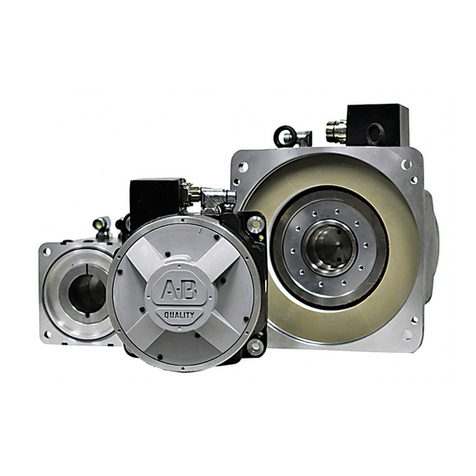
Allen-Bradley
Allen-Bradley Rockwell Automation RDD Series installation instructions
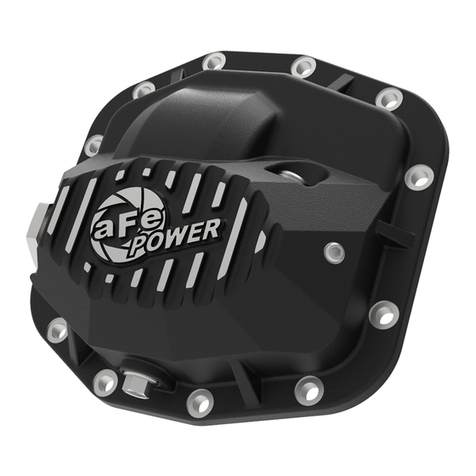
DANA
DANA BREVINI T Series Installation and maintenance manual
